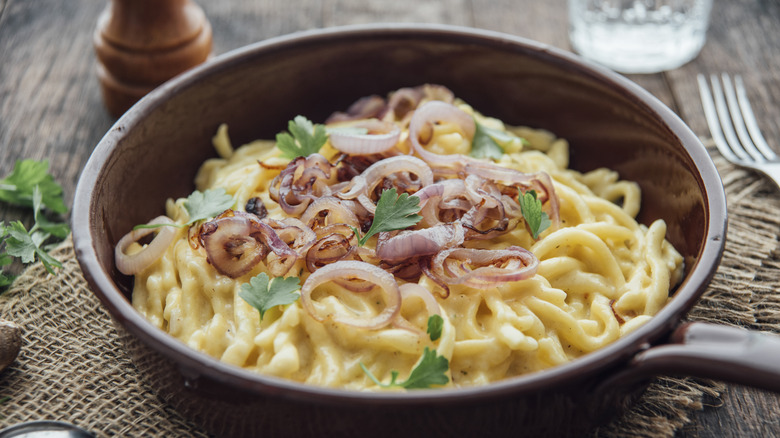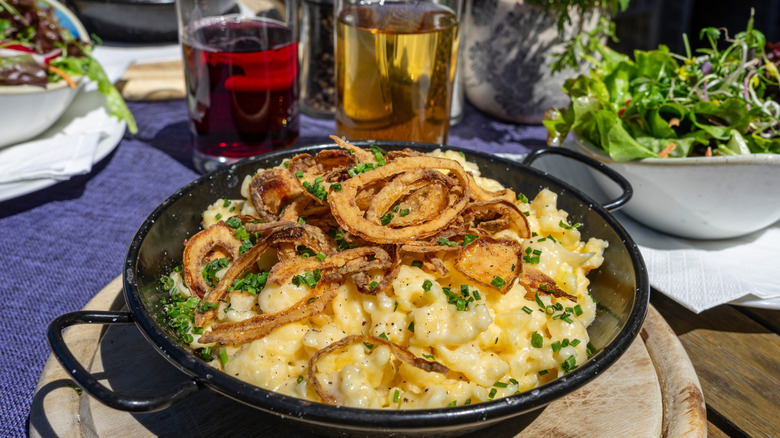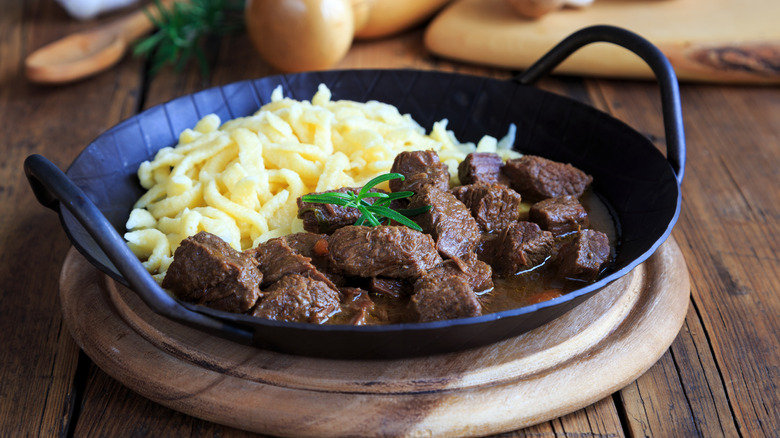What Makes Käsespätzle Different From Spätzle?
When you first think of German cuisine, you likely don't imagine pasta. However, egg noodles called spätzle are actually a favorite in the Southwest regions of the country. Traditionally handmade with a cutting board and a colander, the noodles have small, irregular shapes and a dumpling-like chewiness. It's comforting, rustic fare that's typically reserved for home cooking and not often seen on restaurant menus.
Spätzle appears in myriad regional forms. It's also enjoyed in Hungary, Switzerland, the Czech Republic, Italy, and Austria, dressed up in a variety of toppings. If you're a fan of cheese-covered goodness, then you'll need to try käsespätzle, a variety of spätzle from the Swabia region of Germany and Tyrol part of Austria. Often compared to an ultimate mac and cheese, this rendition consists of the hand-made pasta topped with melted cheese, fried onions, and often some eggs and butter. It's a delicious, hearty preparation that's worth investigating.
Käsespätzle is spätzle topped with cheese
Käse translates to "cheese" from German, so the name itself references this dish's combination of the egg noodles with dairy. As with other spätzle dishes, the egg noodles are formed from scratch with flour, eggs, milk, butter and salt. After boiling, the magic's all in the cheese topping.
Typically, the dish features Emmentaler cheese. This semi-firm Swiss cheese packs in a range of nutty, fruity, and mild flavors. It has excellent melting properties, hence its popularity in crafting käsespätzle. Alternatively, chefs may use a stronger Gruyère for extra flavor. For a softer take, the pasta can be topped with cottage cheese or quark. What's dependable is that the sourced cheese is crafted from high-quality dairy, and this is a sense of pride for chefs.
Another integral part of käsespätzle is an abundance of fried onions. To tie it all together with extra fat, chefs nearly always add butter. From there, any other components depend on the individual recipe. Past salt and pepper, some season the dish with nutmeg. Others will add a chopped chive garnish. And, while it's often served in a bowl, you'll often find käsespätzle cooked in a large casserole dish that's built for sharing.
Spätzle comes in many additional forms
Käsespätzle is a mouth-watering take on spätzle — however, it's not the only one. Like other doughy creations, the dish is a wonderful vessel for rich sauces and zesty toppings. You could try topping it with everything from an underrated beef braise to a batch of sauerkraut. With spätzle's presence in many culinary contexts, you can also turn to a range of cuisines for inspiration.
German renditions of spätzle vary. In the most common, the dough dumplings are sauteed and combined with breadcrumbs, onions, herbs, bacon, mushrooms, and more. The noodles aren't confined to the flour-based mix; they're also made from cauliflower, whole grain, and whole wheat. Chefs alter the shapes, too. Some noodle are longer strands like spaghetti and accompany meats, while shorter noodles are served like a standalone bowl of porridge.
Meanwhile, in Hungary, spätzle is used to soak up aromatic, paprika-based sauces. It's the accompaniment to the beloved chicken paprikash and is paired as a side to a delicious bowl of goulash. The dish is also enjoyed in the northern Italian region of Sudtirol. Here, the dough is sometimes enhanced with spinach or liver to emphasize the flavor of the noodles. Topped with a butter-based nutmeg sauce, it's a delightful kind of hearty mountain food.


